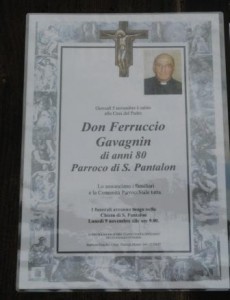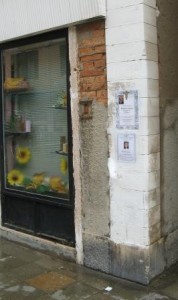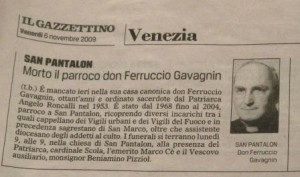A reader has written to ask for some elucidation on my phrase “death notices taped up around the city” in my post “RIP don Ferruccio.”
There are several ways to announce the decession (it ought to be a word, so now it is) of your loved one. You have your choice of any or all of them, depending on how much money you feel like spending.
- What I called a “death notice” is a plasticated rectangle the size of an 8 1/2 x 11 sheet of paper with a photograph and some salient details concerning the deceased: Name, age, names of surviving relatives, the name of the funeral home, funeral details, and usually some additional phraseology to express grief, hope, and/or faith.

This is a typical design for the notices that are taped up; in this case, don Ferruccio's was tacked to the church door. One of the most common ones translates as “No one dies as long as they live in the hearts of those who love them.” I think that’s painful. Anyone who has lost someone dear to them knows perfectly well that the person is dead, no matter how much love they may feel. Makes it sound as if loving the person is practically the same thing as having them there in the flesh. End of unsolicited opinion.
These notices are taped up around the neighborhood on convenient corners. There’s a corner near us which seems to be a common favorite; sometimes there are two or three stuck there. Lino calls it the “Wailing Wall.” But it is a very useful way to let people know what’s happened, and often little clumps of people will stop to read it and discuss the person and express feelings or opinions. Sometimes, to save money, the family will photocopy the notice and tape that up. I think that’s painful too.

The cost of these plastic announcements is usually included somewhere in the total cost of the funeral, though the job of sticking them up on walls is completely up to one of the family members, or whoever feels like doing it. I think it’s inexpressibly sad to see, say, the widower taping up the melancholy announcement about his wife on whatever corner seems right to him. But then again, maybe doing it helps somehow. What’s really sad is to see someone taking it down after the funeral.
However, you can also order them separately from a funeral home, even if you haven’t engaged them. In that case, they cost about 5 euros ($7.42) apiece.
- Your other option is a notice in the Gazzettino. These are not really obituaries as they don’t say much beyond the barest basics of the situation. However, the cause of death is never mentioned. In some cases you can deduce it if the family has included a special thank-you to the doctors, staff and clinic/hospital. Hard to mistake if the gratitude goes out to the oncology department.

Whether to put the news in the paper might be a very easy decision to make when you hear the price, which is generally calculated by the line rather than the word. In any case, the minimum is 300 euros plus 20 percent tax (360 euros or $534). If you want to add a photograph, it starts at 150 euros plus tax (180 euros or $266).
- If you are not directly involved in the bereaved family, you have economy option: You can add your name to the published notice to notify the world that you share the family’s sorrow. For five names (“Laura and Federico with Annamaria”) is 50 euros plus tax (60 euros or $89). If you add more names, you spend more money.
If the person who has gone to glory is sufficiently notable, a small article will be published. Presumably this doesn’t cost anyone anything, but I can’t promise that. You just never know in this world.


2 Comments
I think it’s sad how peoples’ grief and the desire to honour a deceased person is exploited for making money. A death notice in a newspaper is not the same as an advertisement, it shouldn’t cost this much! 🙁
It won’t surprise you to hear that I completely agree with you. In fact, I think they should be free. In a sense, the paper is rendering a public service and as you say, they’re not anything like advertisements.